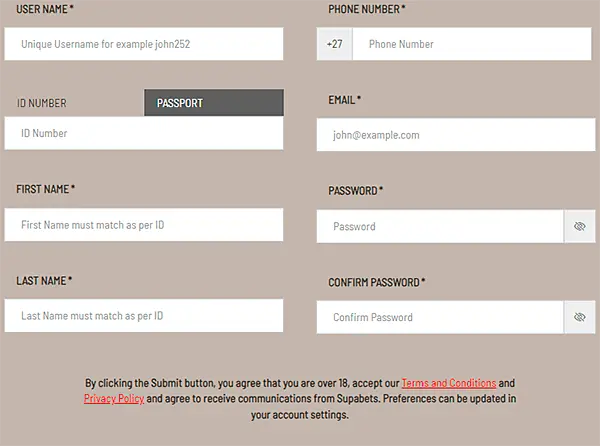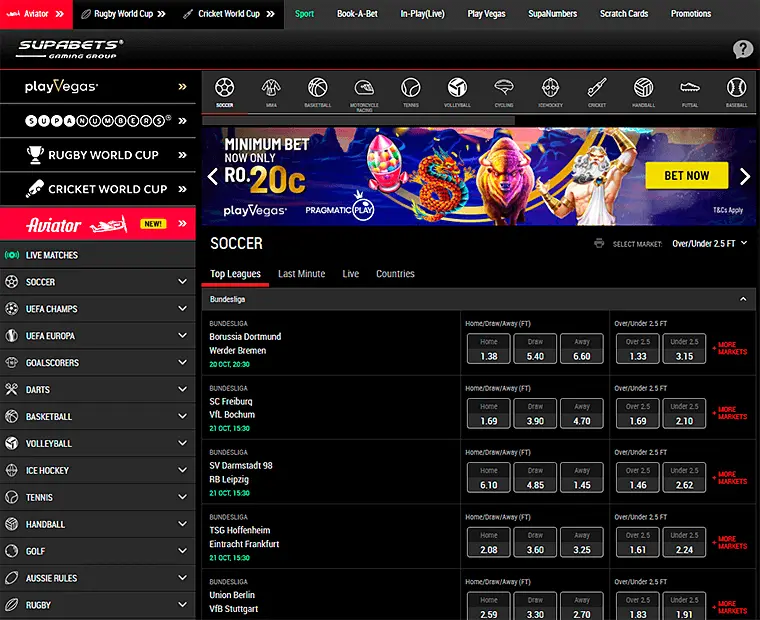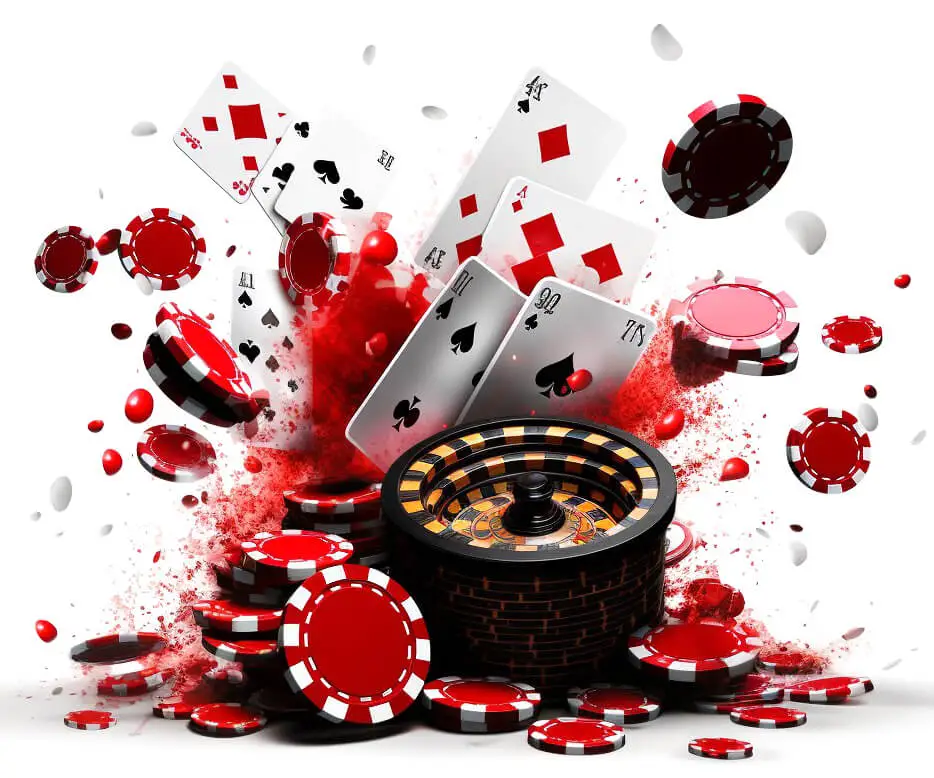Supabets - South Africa's Favourite Online Betting Site
Use the Buttons Below to Register or Login:
At SupaBets, we believe in giving South Africans the best in betting. That’s why we’ve crafted special offers just for you. Explore our exclusive deals and enjoy the ultimate betting experience tailored to South Africa’s finest! GET VIP OFFER

With over a million registered members, Supabets has emerged as one of the most popular online betting destinations for South African punters. Their comprehensive sports betting coverage, rewarding casino gaming options, and seemingly endless bonuses keep players coming back.
In this in-depth Supabets review, we’ll cover everything you need to know about their platform – from breaking down the registration and verification process to evaluating their sportsbook odds and casino game variety. You’ll get the full rundown on Supabets’ payment options, mobile compatibility, customer support, and more to see if they’re the right fit for your betting needs.
Getting Started with a New Supabets Account
Registering a new account at Supabets takes just a couple of minutes. Start by visiting Supabets.co.za and clicking the prominent “Register” button. This will bring up the quick sign-up form where you’ll enter some personal details including:
- Full name and surname;
- Email address;
- Mobile number;
- Physical address;
- Date of birth;
These standard details allow Supabets to verify your identity and set up your account profile. Once submitted, you’ll receive a one-time PIN code sent to your mobile number. Input this OTP code to verify your device and complete the registration.

Next comes the FICA verification process. This is required by South African gambling regulations to legally activate your account. You’ll need to provide a copy of your valid green bar-coded ID or passport plus proof of your residence showing your physical address.
Supabets offers a few ways to submit your FICA documents:
- Upload copies directly through your account dashboard in the FICA section;
- Email scans or photos of your docs to [email protected] ;
- Send via WhatsApp to 071 550 4018;
Once received, their team typically processes verifications within 1-2 working days. Then you can make your first deposit and begin betting!
Why Choose Supabets in South Africa?
South Africa has no shortage of online bookmakers, so what makes Supabets stand out from the crowd? Here are some of the key advantages Supabets offers to win over players:
- Massive welcome bonuses – Up to R5,000 in free bets and matched deposit bonuses for new accounts; 💰
- Enormous betting markets – One of the largest selections of sports & game odds in SA; ⚽🏏🎰
- Instant deposits & fast payouts – Wide banking options with quick processing;💨💨
- Proven reputation – 10+ years in business with over 1 million customers 🏆
- Ongoing rewards – Regular promos, odds boosts & cashback for players; 🎁
- Top-tier live casino – Authentic games with real dealers; 🎲
With these advantages combined, Supabets provides a rewarding and reliable platform to bet and play your favourite games online.
Reliability and license Supabets
Full Name and Registered Address: Portapa 2 (Pty) Ltd t/a SUPABETS is licenced by Mpumalanga Gambling Board. Registration No. 2009/016148/07. 37 Fricker Road, Illovo, Johannesburg, Gauteng, 2196.
Supabets is more than just an online betting platform; it boasts a substantial network of offline establishments.
People can place their bets not only online but also in person at these designated locations:
Newtown
First Floor a
44 Diagonal Street City and Suburban
Newtown, Johannesburg.
Hammanskraal
Kopanong Kudube Shopping Centre
Douglas Rens Road
Kudube Ext 4.
Bellville
Shop 5 Golden Corner Centre
Voortrekker and Durban Roads
Cape Town.

For a comprehensive list of addresses and their operating hours, you can refer to the official website’s directory section.
From this, one can conclude that Supabets is a serious player in the industry with a strong focus on capturing a significant market share. The company is committed to growth and providing competitive conditions for both new and experienced players.
Claiming the Supabets Welcome Bonus Pack
As an added incentive to join Supabets, new players can claim one of the most generous welcome offers in South Africa. Their new account bonus package consists of:
- No deposit free bet – R50 free wager added after registration; 🆓
- 1st deposit bonus – 100% match up to R2,000; 💰
- 2nd deposit bonus – 50% match up to R1,000; 💰
- 3rd deposit bonus – 100% match up to R2,000; 💰
This adds up to as much as R5,000 in free bets that Supabets will double on your first few deposits! 🤑 While certainly enticing, there are some bonus terms to keep in mind:
- Wagering requirement of 10x the bonus amount; 📜
- Bonus funds must be used within 30 days; ⏱
- Minimum R50 deposit to claim the offers; 💵
- Max bonus winnings capped at R1,000; 💸
As long as you can meet the wagering requirement by betting 10x the bonus funds on odds of 3/10 or higher, you can withdraw any winnings from the welcome bonus! 💎

⛔️ Attention: conditions and amount of bonuses are constantly changing, so the information stated here may not be up-to-date. We advise you to check the latest information in your profile or through support. ❗️
Placing Your First Bets on Supabets
Once your account is verified and funded with a deposit, it’s time to start exploring the Supabets sportsbook and placing your first bets. Let’s look at the key features that make betting here so enjoyable:
Sports Variety
Supabets delivers betting markets on over 20 sports. For South African punters, the most popular leagues to wager on include:
- Soccer – PSL, English Premier League, La Liga, Champions League, World Cup and more;
- Rugby – Super Rugby, Currie Cup, Six Nations, Rugby Championship, World Cup;
- Cricket – Test matches, ODIs, T20 leagues like IPL, MSL, and Big Bash;
- Tennis – Grand Slams, ATP & WTA tours, major events like Wimbledon;
- Golf – Majors, PGA Tour, European Tour, Ryder Cup, Presidents Cup;
Within each sport, you’ll always find markets for upcoming matches along with plenty of futures betting opportunities too.

Bet Types and Markets
No matter which sports pique your betting interest, Supabets will have you covered with an immense variety of wagers to choose from. The most common bet types include:
- Match winner – Pick the outright winning team or player;
- Handicaps – Bet with simulated margins to level the field;
- Totals – Wager over/under a set number of points/goals;
- Props – Bet on player performance milestones, statistics, and specials;
- Accumulators – Combine multiple picks into one bet for bigger payouts;
In addition to regular full game bets, you’ll also gain access to lucrative in-play betting once matches get underway. Supabets provides live odds on many sports to wager on as the action happens. Their cashout feature also allows settling bets early to secure profits or minimize losses before the final whistle.
Competitive Odds
The odds available at Supabets remain competitive with other top South African betting sites. You can often find slightly better odds in their unique boosted betting markets. These enhanced odds promotions run periodically and are a great way to secure extra value on your bets.
Between their wide market variety and the typical odds, Supabets gives you a strong chance to consistently beat the bookie across both popular sports and niche leagues.
Supabets Casino and Other Gaming Options
Beyond sports betting, Supabets also delivers a stellar online casino packed with hundreds of slots, table games, live dealers, and more. Let’s explore the main gaming categories:
Slot Machines 🎰
Supabets provides one of the largest slot collections in South Africa with over 500 titles from leading developers like NetEnt, Red Tiger, Habanero and more. Whether you enjoy classic fruit machines, branded blockbuster slots, or mega jackpot games, they have you covered.
Some of their most popular slots include:
- Aviator ✈️
- Hot Hot Supabets 🔥🔥
- Supabets Slots 🎰
- Gates of Olympus 🏛️
- Hot Hot Fruit 🔥🍒🍋🍌
- Mystic Fortune Deluxe 💎
- Sweet Bonanza 🍬
- Lucky Lucky 🍀
- Wealth Inn 💰
- Egyptian Dreams Deluxe 🐪🌙
- Mega Wheel 🎡
- Buffalo King Megaways 🐃👑
- Monopoly Live 🎲
- Crazy Time ⏰
You’re sure to find plenty of new favourite slot games here.

Table Games 🎲
Supabets provides all the classic table game favourites like online blackjack, roulette, baccarat, and poker. For the real casino experience, head to their live dealer tables where real human croupiers host games streamed in crisp HD quality.
The live games add bonuses, side bets, and other features not found in RNG games. Popular live tables include:
- Live Blackjack – Bet behind other players or take empty seats; ♠️♥️♣️♦️
- Live Roulette – Chat with the dealer while watching the wheel spin;
- Live Baccarat – Squeeze your own cards at real tables; ♠️♥️♣️♦️
- Live Poker – Texas Hold’em, Three Card Poker, and Casino Hold’em;
Supabets also offers unique live game show variants like Dream Catcher, Mega Ball, and Football Studio.

Instant Games ⚡️
The Instant Games section delivers a massive buffet of digital scratch cards, bingo games, keno, and video poker. These fast-paced games provide instant gameplay and results using engaging graphics and themes. They are perfect for a quick betting fix when you don’t have time for in-depth slots or table games. 🎮
With so much variety across their sportsbook and casino, boredom is never an issue at Supabets! 🥳
Lottery 🎟️
For players who enjoy betting on lottery outcomes, Supabets provides extensive lottery betting markets from South Africa and around the world. The section with bingo games on the site is called “Supanumbers”. You can wager on the numbers for:
- Lotto;
- Powerball;
- Daily Lotto;
- EuroMillions;
- MegaMillions;
- Oz Lotto;
- SuperEnaLotto;
Instead of buying tickets and waiting for the draw, you can bet directly on the winning numbers being pulled. 🎰 Supabets also covers local African lottery games like SupaNational, Ghana Lotto, Zambia Lotto, and more. 🌍
Payment Methods and Cashier Options
Supabets supports numerous payment methods tailored specifically to South African players. Your available options may vary slightly based on your bank and region, but generally you can deposit and withdraw using:
Deposit Options
- Instant EFT – Fast online bank transfers;
- VISA/Mastercard – Credit & debit card deposits;
- SID Instant EFT – Voucher payments at retailers;
- SnapScan – Instant scans from your mobile wallet;
- EcoPayz – Virtual ecoCard or ecoVoucher;
- Sambapay – Deposit at your nearest Sambapay agent;
| Deposit Method | Mininmum Deposits R | Maximum Deposits R | Process Time |
| OZOW | 1.00 | 1,000,000.00 | Momentary |
| SID Instant | 1.00 | 1,000,000.00 | Momentary |
| Peach Payment EFT | 20.00 | 1,000,000.00 | Momentary |
| 1ForYou Voucher | N/A | N/A | Momentary |
| OTT Voucher | N/A | N/A | Momentary |
| Supabets Voucher | N/A | N/A | Momentary |
| KAZANG | N/A | N/A | Momentary |
| Blu Voucher | N/A | N/A | Momentary |
| PayU | 20.00 | 1,000,000.00 | Momentary |
| Peach Payment Credit Cards | 1.00 | 1,000,000.00 | Momentary |
| DPO PayGate | 20.00 | 1,000,000.00 | Momentary |
| Master Pass | 20.00 | 1,000,000.00 | Momentary |
| MTN MoMo | N/A | N/A | Momentary |
| Direct Deposit | 1.00 | 1,000,000.00 | Momentary |
Withdrawal Methods
- Bank transfer – Up to R150,000 per day;
- Courier cheque – Up to R50,000 per day;
- Instant Cash – Pick up at Money Market counter;
| Withdrawal Method | Minimum Withdrawal R | Maximum Withdrawal R | Processing time |
| Bank Transfer | 50.00 | 5,000,000.00 | 1-2 Days |
| FNB eWallet | 50.00 | 2,5000.00 | 24 Hours |
| Standard Bank Instant Money | 50.00 | 28,500.00 | 1-2 Days |
| Email Request | 50.00 | 5,000,000.00 | 24 Hours |
| Sparkle Pay | 50.00 | 5,000,000.00 | 24 Hours |
Compatible on Mobile Devices
Supabets offers a fully optimized mobile site compatible on any iOS or Android smartphone and tablet. The layout automatically fits your screen size while still delivering the full range of sports and casino options.
You can register, deposit, bet, and withdraw seamlessly through their mobile site without downloading any apps. Navigation remains intuitive with important links accessible from the top menu.
As of October 2023, it has not been established that this bookmaker provides standalone mobile applications for Android and iOS-based smartphones and tablets. On the one hand, the lack of an app can be considered a disadvantage. But if the Supabets mobile site is convenient and constantly improving, it serves as a counterbalancing factor.

Reliable Customer Support
Should any issues arise, Supabets provides customer support through several convenient contact channels:
- Phone – Call 011 215 7000 or the toll-free help line;
- Email – Send queries to [email protected] ;
- WhatsApp – Message 071 550 4018;
- Live Chat – Chat instantly on the site;
Their local support team is available 7 days a week during standard South African business hours. We found the quickest responses through live chat, with most issues resolved in just a few minutes. Email and WhatsApp queries are also promptly answered within a few hours in most cases.
If you’d rather help yourself, Supabets co za provides an extensive FAQ and Help section that covers account management, deposits and withdrawals, technical issues, and general betting guidance. Between their solid knowledge base and friendly customer support, you’ll get assistance quickly when needed.
Final Thoughts on Betting with Supabets
Our in-depth review has covered all the key points South African players need to know about the Supabets betting platform.
Pros. Their strong welcome bonus, immense sports betting markets, diverse casino game selection, and accessible customer support make Supabets a top choice.
Cons. One notable limitation is that Supabets does not offer a dedicated mobile app available on platforms like the App Store or Google Play. While this might be considered a drawback for some users, others may find the mobile version of the website perfectly comfortable and accessible.
While their site design seems crowded at first glance, the sheer volume of content is laid out logically overall. Navigation remains simple with so many sports leagues, casino titles, and bonuses just a click or tap away.
For your next bet, sign up and give Supabets a try to see why they have earned a stellar reputation and claim over 1 million satisfied players in South Africa!


